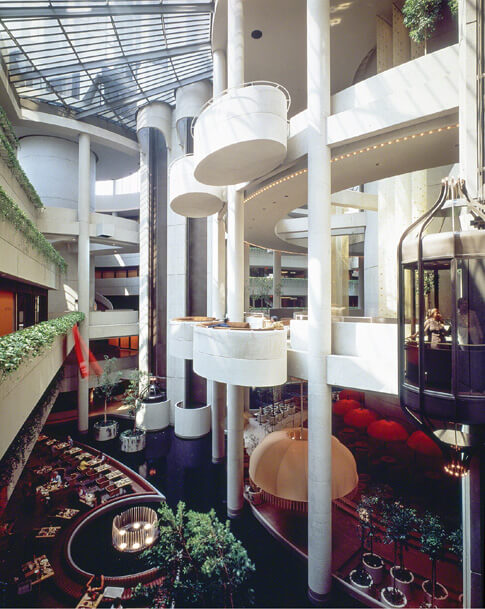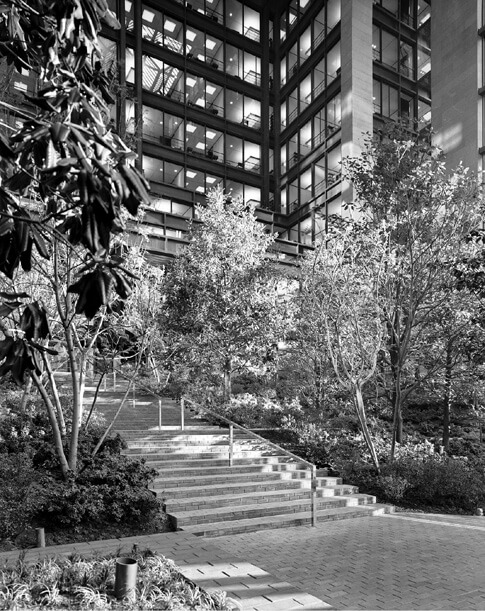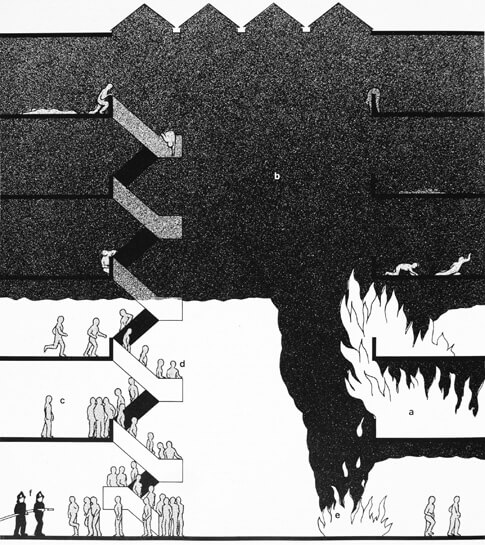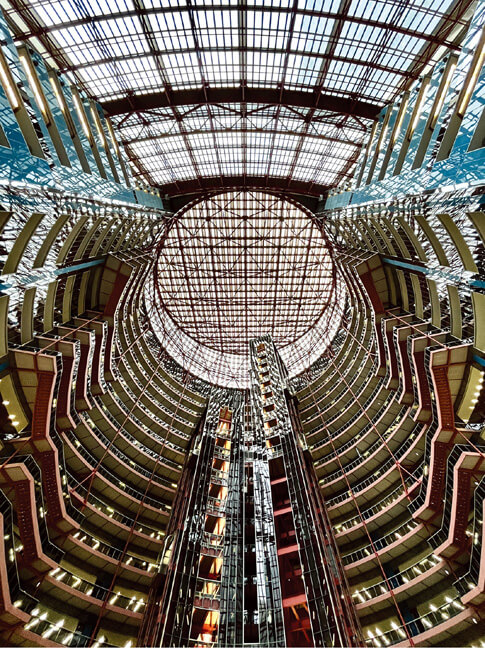Atrium by Charles Rice | MIT Press | $44.95
Everyone likes atria: few have given them much thought. Charles Rice, professor of architecture at the University of Technology Sydney, is here to fix this. His 2016 book Interior Urbanism: Architecture, John Portman and Downtown America focused on the first architect one would word associate with the feature. He’s now looking at the rest of the crop from the last half century or so in his new book, Atrium.
Atria made tremendous sense as a novel feature in hotel marketing; it’s a little harder to explain how they spread to other building typologies but Rice accomplishes this task with excellent results. There’s not a specific programmatic justification for atria. They are a category beyond, as Rice pointed out, theater foyers or transit concourses or shopping malls, or other uses that need a triple or octuple-height space. “Unlike these kinds of spaces, the atrium does not necessarily belong functionally to the building types in which it appears.”

Some atria within the book are reasonably well-known: Van der Ryn and Calthorpe’s Bateson building, John Andrews’s Instelstat, or Peter Foggo’s 1 Finsbury Avenue. But most atria are designed by corporate firms and developers seeking Class A status or a grand luxurious calling card. Many building trends spread simply because someone sees a recent feature and decides they want it also, but there’s much more going on here.
The atrium rose to prominence during an era of affrighted urban introversion, as an atrium did the work of sanitizing unruly public into monitored private spaces. Rice called this phenomenon “simultaneously an act of opening and an act of enclosure.” Jameson’s Bonaventure gloss is here, as it should be, if cultural understanding of atria has certainly shifted since 1991 in actively less dystopian directions. Other associations are still with us, sometimes for the worst. The book opens acknowledging the Trump campaign’s launch in the eponymous tower atrium, describing the event as “the culmination of the politics of this new American city and its voided public space.”

Rice’s book is framed not around stylistic or chronological segments but practical ones: chapters concern air conditioning, interior planting, and corporate organization. He draws upon canonical content from Reyner Banham and Reinhold Martin as well as more recent work by the likes of David Gissen and Daniel Barber, but he really zooms in on dustier realms of 80s U.K. business consultancy. These inputs don’t really have that much to do with how a space will actually look; the calculations involved usually aren’t even structural. The Cambridge Center for Land Use and Built Form, which provided early impetus to atria construction did so hand-in-hand with their elucidation of the concept of a “built volume factor,” a floor area ratio analogue that suggested a comparable computer-enabled ability to envision buildable space in ways that aren’t easily comprehensible to even the skilled drafter. It was a technology-driven “algorithmic encoding of form.” It was a new frontier of doing things: Obviously it didn’t abandon design but design was often the result of factors other than building from a sketch to a plan. It became simpler to figure out how to slot an atrium into a building site without squandering buildable space, so people did it.
Energy performance is another focus. While Rice’s examples are all in temperate climates that require seals, he stresses a point that many do not realize—atria are often energy-saving in winter (summer a different story), adept at reducing conductive heat loss from surrounding built volumes. They also make great use of natural light (often prompted by needs for interior planting) working with—or at least not entirely against—nature. The trend was accentuated by the mid-70s energy crisis.
Introducing a huge space into the middle of buildings also shook up the idea that there were precise temperatures to produce maximally febrile working solutions. Achieving a target temperature on a floor that’s ten feet high is relatively straightforward; achieving that for one 100 feet tall is not. The quandary encouraged the idea that perhaps it was simplest to be less of a climate control freak. “As rigid conceptions of comfort tied to thermal stability were seen to contribute to inefficient and unhealthy buildings, the potential for variability in the atrium’s performance helped loosen the hold air-conditioning had on the production of habitable indoor environments,” Rice wrote.

These spaces had other residents who might not function all that well at 68 degrees under recessed fluorescent lighting, namely plants. Plants in any space are mainly symbolic of health and attention; a few in an apartment suggest a reasonably functional resident, and this is also true of a public building. Rice’s description of the Ford Foundation atrium is spot-on: “The landscape could be understood to signal a kind of false consciousness: a flourishing landscape signifying a flourishing organization, one that was deeply involved in developing new, engineered agricultural solutions in the so-called developing world.” Hertzberger’s Centraal Beheer relied on employees bringing in their own plants. This attention is either sort of nice or it’s an active Tom Sawyer–like prompt for your employees to greenwash the fence.
Sometimes these gardens were environmentally conscious. At other times they required enormous amounts of carbon to sustain. The point isn’t any intrinsic sustainability but rather their “rhetorical function to garner agreement.”

The result of Rice’s exploration is an understanding that your beautiful atrium with plants and cafe tables and a waterfall and string quartets on occasional Wednesdays is not designed to do anything specific. It is designed to accomplish an inchoate experiential function.
Corporate consultants loved and encouraged this idea; the atrium is the spatialized icebreaker, muffin breakfast, and cocktail event all in one. These were deliberately, as Rice explains, “arrangements that took employees ‘outside’ their regular work areas to demonstrate and reinforce, via a type of social interaction, the larger corporate structure in which they were enclosed.” Homo economicus is pleased in the vivarium.
Rice mentions a crucial point early on. Atria were a means of inviting in and taming a new and unfamiliar element; bring a dog or a child or a writer into your home and your idea of perfect functionality will be shaken up but basic order will still be reestablished. “Akin to the atrium itself, architecture is seen as a discipline that operates in the distinction between what belongs within it and what is deemed to be outside of it, a distinction that has been actively and continually processed.” Rice’s key accomplishment is explaining the rise of atria from a welter of rather disjointed converging factors, “those of technical expertise in place of disciplinary erudition, building performance in place of architectural importance, spatial indeterminacy in place of programmatic intention, and organizational strategy in place of user accommodation.”

He closes on a familiar topic, Jahn’s Thompson Center in Chicago, where an atrium is about to experience exactly these push-and-pull influences—which are not really about any fixed features but rather a shifting and nebulous but specific idea of utility.
“Whether Google preserves the Thompson Center’s atrium in its current form, changes it dramatically, or even fills it in, makes no difference in terms of the possibilities the atrium offers. Each would be a legitimate strategic approach to the material conditions of the existing atrium, and the organizational needs projected for the building.” We hope not, but the atrium as strategy is quite different from the atrium as a fixed thing.
Anthony Paletta is a writer living in Brooklyn.

